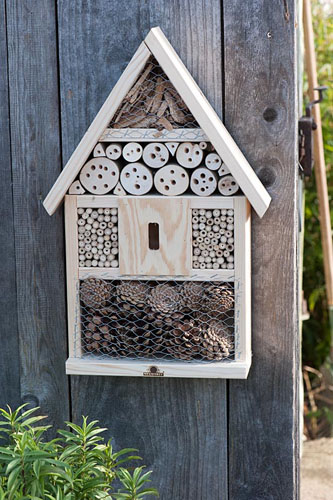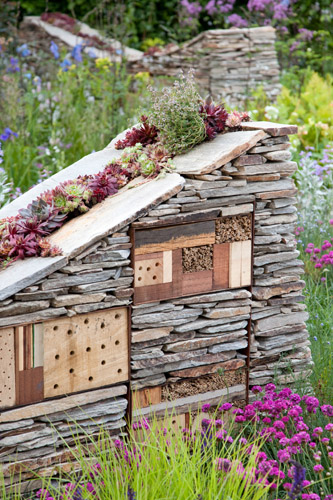
One of the things that everyone's been thinking about in the world of landscape design is how to protect the pollinators and encourage "good bugs" so that our gardens and landscapes will be healthier and more sustainable. Some homeowners are in the habit of "cleaning up" the garden within an inch of its life, leaving no leaf litter or dormant perennial stalks, no fallen trees or piles of sticks - blowing it all away down to the bare dirt. This may create a "tidy" look, and it may "take less time" to use a leaf blower than a rake, but there are SO MANY reasons not to do this! Leaving aside the air and noise pollution created by leaf blowers, their health hazards to those who use them, and the soil compaction that results from having 180 mph hot air blown at it - what about the habitat that's being taken away?
Insects of all kinds need places to overwinter and to create their nests. If there are no nooks and crannies, no hollow stems, no rotting logs, no decaying leaves available, those pollinators and beneficial bugs will leave your yard and find somewhere else to be. Poof - no pollination for you!
The good news is that you can create habitats for beneficial insects by collecting natural or salvaged materials into one place, where multiple types of insects can overwinter and nest. They're easy and fun to make yourself, and can become works of art if you want them to be. Maybe more attractive and effective in a small yard than keeping a not-very-extensive "wild area" somewhere. You may have to replace some of the elements every late-summer, but its a great way to "recycle" old bricks, leftover stone, tile shingles or old crates. You can make pruned branches or old firewood into art just by arranging it in an orderly fashion. Add some pinecones and some cut pieces of bamboo. If you have leftover wood, drill holes into a block of wood to create habitat for bees who nest in hollows.
If you google "insect hotel" you'll come up with some pictures and some instructions - then let your imagination take over. Pay attention, though, to where to place (or to build) your insect hotel once its finished - the insects will need afternoon sun to keep warm.

Here's a simple example about how stacking some old bricks in an unused part of your garden bed then inserting twigs, hollow stems and dried grasses in an orderly fashion creates both art and habitat.
These are some of the elements you can include:
- A compartment with a red-colored slitted door filled with wheat straw will attract Green lacewings, ladybugs and earwigs and provide them with a place to hibernate from the middle of September until early April. Lacewings devour aphids and other pests such as scale insects, many types of caterpillar and mites. Another way to make a good lacewing habitat is by rolling up a piece of corrugated cardboard and putting it in a waterproof cylinder, such as an old plastic bottle.
- Lots of different kinds of bees make their nests in hollow sticks, hollow plant stems or holes in wood made by wood-boring insects. Mason bees (Osmia), masked bees (Hylaeus) and solitary wild bees all will use different diameters of holes. There are many different species of solitary bee, all are excellent pollinators. The female bee lays an egg on top of a mass of pollen at the end of a hollow tube, she then seals the entrance with a plug of mud. A long tube can hold several such cells.
- A compartment filled with pine cones provides lots of safe spaces for lots of differenet insects, including garden spiders.
- Dead wood is an increasingly rare habitat as we tidy our gardens, parks and woodlands. It is essential for the larvae of wood-boring beetles, such as the stag beetle. It also supports many fungi, which help break down the woody material. Crevices under the bark hold centipedes and woodlice. Place rotting logs at the base of your hotel so the logs stay nice and damp and mix with other decaying plant matter to attract centipedes (which devour slugs) and other woodland litter insects such as millipedes and woodlice (which will provide a welcome source of food for birds). This is also a great spot for garden spiders.
- Frog hole. Frogs eat many slugs and other garden pests. Although they need a pond to breed in, they can spend most of the year out of water. We use stone and tiles as these provide the cool damp conditions amphibians need. Newts may also take advantage of these conditions. Amphibians need a frost-free place to spend the winter; this could be in the center of the habitat you create, inside the base of a dry-stone wall, under a pile of rubble or deep underground.
- Straw and Hay provide many opportunities for invertebrates to burrow in and find safe hibernation sites.
- Twigs, sticks and stems: Bundled together, sticks and twigs of different sizes offer welcome lodgings for ground beetles. These beetles chomp away at many of the pests that attack our crops, including aphids and carrot root fly larvae. You'll also be offering a vacancy to ladybugs, which eat aphids and mites. The adults hibernate over winter; they need dry sticks or leaves to hide in. Hoverflies will also be attracted to this type of material. Hoverflies are both pollinator and pest patroller – the larvae carry an insatiable appetite for aphids while the adults feed on nectar as they pollinate flowers.
- Loose bark is a habitat for beetles, centipedes, spiders and woodlice, who all lurk underneath the decaying wood and bark. They help to break down woody plant material and recycle it back into compost.
- Dry leaves mimic the litter on the forest floor and provide homes for a variety of invertebrates.
- Crevices are important places for hibernation through the winter. Make sure your insect hotel has plenty of different types of crannies and crevices.
- Bumblebees. Every spring queen bumblebees search for a site to build a nest and found a new colony. An upturned flowerpot in a warm sheltered place might be used.
Seen below in the picture is a FABULOUS idea - incorporate both a mini "green roof" and insect habitat to construct a decorative stacked-stone wall. This one looks like it might be one of two that define an entry into the next garden room - which looks like it might be a meadow.

Which reminds us that we need larval foods and nectar-producing flowers as part of the habitat as well. Make 2015 the year when you do something artistic and whimsical to protect the pollinators!